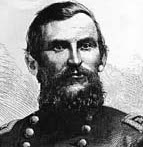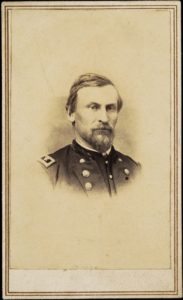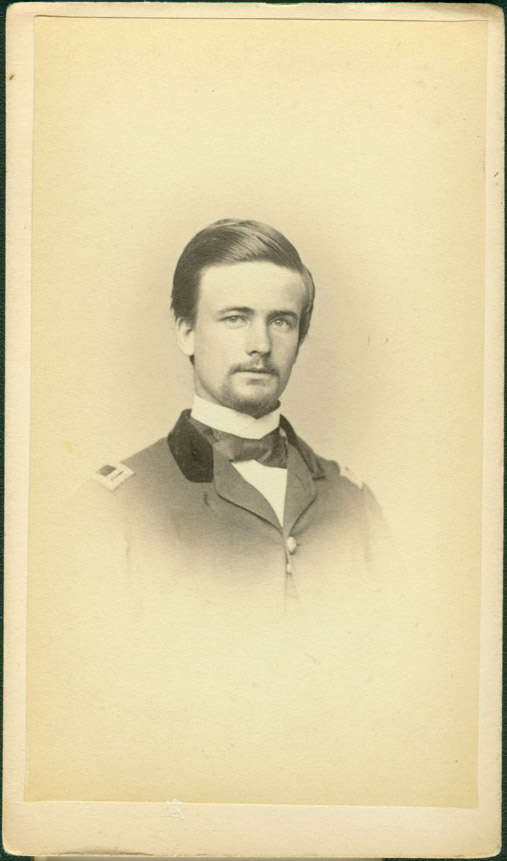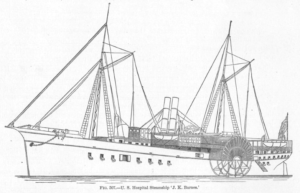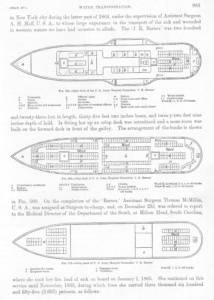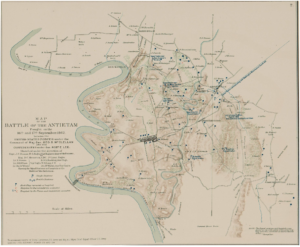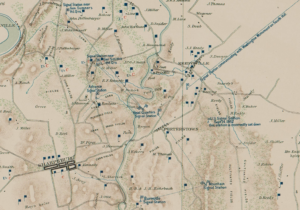Credited to Matthew Brady, this 1864 photograph is in the collection of the Library of Congress, and is labeled
Petersburg, Va., vicinity. Maj. Thomas T. Eckert (seated, left) and others of U.S. Military Telegraph Corps
Major Thomas Thompson Eckert was General McClellan’s chief of telegraphic operations on the Peninsula and Maryland Campaigns of 1862, later Chief of the Military Telegraph Office at the War Department and Assistant Secretary of War, and, much later, President then Chairman of the Western Union Telegraph Company, to 1910.
Ramsey and Leib (1865)
21 December 2022
At left here is brevet Lieutenant Colonel and AAG Robert Hampton Ramsey (1838-1876), of General George Thomas’ staff, previously of the 45th Pennsylvania Militia, and on the right a very tired-looking Captain Edward Henry Leib, former First Defender from Pottsville, PA and brevet Major, 5th United States Cavalry.
This is late 1865 and Leib is probably still recovering from a gunshot through his body received at Five Forks, VA on 1 April. Captain Leib was at Antietam in September 1862 and in more than 100 other actions during the war.
His Army career ended in disgrace in 1877, however, due to drinking and conduct unbecoming, related to a “severe and depressing domestic affliction” – unpleasant assertions about his wife and “an affair of honor” with his commanding officer.
Frohne’s Historic Military sold this fine carte-de-visite photograph in about 2010; I found it on ancestry.com.
Genl. Buford & Aides (1863)
20 December 2022
This photograph of General John Buford with four members of his staff is among Civil War Photographs, 1861-1865 at the Library of Congress.
From the print:
left to right: Bvt. Lt. Col. Myles Keogh, Maj. Gen. John Buford, Capt. Peter Penn Gaskell, Capt. C.W. [Craig Wharton] Wadsworth, Lt. Col. A.P. [Albert Payson] Morrow.
Two of these men, General Buford and Captain Myles Walter Keogh, were on General McClellan’s staff at Antietam on 17 September 1862.
E.C. Allen to President J.K. Polk (1849)
19 December 2022
Young Ebenezer Clough Allen was desperate to become a professional soldier but his parents wouldn’t let him enlist for war with Mexico in 1847. He applied to the Secretary of War in January 1848 for a spot at West Point, but was not appointed. In November 1848 he wrote President James K Polk for help. Still no luck. Persistent, he wrote the President again in February 1849 – an emotional and sincere 3 page missive asking for a direct appointment to the Academy.
There’s no response from the President in the file in the US Archives with his letter, but you’ll not be surprised to know the result was the same: no appointment.
The next year Ebenezer enlisted as a Private in the 3rd United States Infantry. He continued in the Army with some success to 1862, by which time he was First Sergeant of Company A, First Battalion, 12th United States Infantry. He was appointed 2nd Lieutenant of his Company in June 1862.
Lieutenant Allen commanded Company A in action at Antietam on 17 September 1862 and was with them at Fredericksburg in December, was promoted to First Lieutenant in January 1863, and was at Chancellorsville in May. He was afterward ill, and died of small pox in December 1863 after 13 years as a professional soldier.
Dagger and sheath (c. 1860)
19 December 2022
At the New York Historical Society.
handwritten in ink: on tag attached to object: Dagger picked / up on battlefield / during Battle of / Antietam / by Col. May H. / Stacey
Then-Lieutenant May Humphrey Stacey was Adjutant of the First Battalion, 2nd United States Infantry at Antietam.
George Crook (c. 1865)
16 December 2022
I’ve just been updating the previously skeletal Antietam on the Web profile for Colonel George Crook (USMA 1852) who commanded a brigade in the Kanawha Division of the US Ninth Army Corps at Antietam on 17 September 1862. In addition to new text I needed a better picture of him than this muddy etching:
I was pleased to find a wartime photo of him I’d not seen before; it was donated to the Library of Congress by Tom Liljenquist in 2021.
If you’re like me, you may be a little surprised by this relatively young face – expecting instead to see this one (also from the Library of Congress):
Keep in mind Crook had just turned 34 years old in September 1862 and the third picture, one most often associated with him in print and online, was taken 15 or more years later in the 1870s when he was in his late 40s/early 50s. Crook is far more famous for his post-war Indian fighting career, so it makes sense that that’s the face we usually see.
I came back to Colonel Crook yesterday after finding a photograph of Captain Samuel L Christie, the staff officer of the Kanawha Division at Antietam who delivered orders to Crook for his brigade to assault the lower bridge over the Antietam Creek that morning. Crook’s later description of that meeting captures something of his personality and the sometimes absurd nature of war:
About ten a.m. Capt. Christ [sic] on Gen. Cox’s staff came to see me, and said, ‘The General wishes you to take the bridge.’ I asked him what bridge. He said he didn’t know. I asked him where the stream was, but he didn’t know. I made some remarks not complimentary to such a way of doing business, but he went off, not caring a cent.
Thanks to Kevin Pawlak for that quote [Emerging Civil War post], which he found in Martin F. Schmitt’s General George Crook: His Autobiography (1946).
To finish the Burnside Bridge story, Colonel Crook wrote in his after-action report of 20 September
I received orders from the general commanding corps to cross the bridge over Antietam Creek after General Sturgis had taken the bridge; but upon my arrival in the vicinity of the bridge I found that General Sturgis’ command had not arrived; so I sent the Eleventh Regiment ahead as skirmishers in the direction of the bridge, and conducted the Twenty-eighth Regiment above the bridge to reconnoiter the enemy’s position, leaving the Thirty-sixth Regiment as reserve. After a labor of two hours, I succeeded in establishing two pieces of Simmonds’ battery in a position to command the bridge and getting five companies of the Twenty-eighth across the stream. I then intended taking the bridge with the Thirty-sixth Regiment, but soon after my battery opened on the bridge General Sturgis’ command crossed the bridge.
Major General Jacob Dolson Cox … surrounded by images of nine of his officers (c. 1862)
15 December 2022
This set of photographs date from 1862-63 and, in addition to General Cox (center), includes 9 of his staff officers. Cox had command of the Kanawha Division/Ninth Army Corps at the start of the Maryland Campaign of 1862 and many of these men accompanied him there.
The other officers are identified, clockwise from the top:
Lt. Col. J.N. McElroy, Assistant Inspector General
Surg. W.W. Holmes, Med. Director
Capt. E.P. Fitch, Chief Quartermaster
Capt. J.W. Barringer, Chief Commissary of Subsistence
Capt. R.B. Treat, Commissary of Subsistence Inspector
Lieut. Theo. Case, Aide-de-camp
Lieut. J.W. Conine, Aide-de-camp.
Capt. S.L. Christie, Aide-de-camp.
Maj. G.M. Bascom, Assistant Adjutant General
Those whose names are links here were specifically mentioned by General Cox for their work on South Mountain that September.
__________________
This portrait photograph grouping is in the Liljenquist Family Collection of Civil War Photographs at the Library of Congress.
Wounded by one of our own shells
14 December 2022
On 22 September 1862 Brigadier General Samuel D Sturgis completed the after-action report for his Division (Second Division, Ninth Army Corps, Army of the Potomac) describing their role on South Mountain and at Antietam earlier that month.
One tiny detail from that report is the following mention of a man I’m sorry to say I’d not noticed before today:
One of my orderlies, Private John Dohmeyer, Company D, Fifth Cavalry, was severely, perhaps mortally, wounded by one of our own shells while at my side near the bridge.
That would be the Lower Bridge – now identified as Burnside’s – over the Antietam near Sharpsburg, MD.
The orderly’s wound was in fact mortal, though the General couldn’t have known that for sure as he was writing. Private Domeyer died at the Locust Spring field hospital on 23 September, the day after the report was submitted.
_______________
Being German-born, his name was probably mangled by various record keepers – at his enlistment, in the regiment, by General Sturgis, and at the hospital – so I’m not sure how it should be spelled. It is likely he was born Johann Domeyer, as that name appears in several Bavarian genealogies, so I’ve used the Americanized first name John with that surname on his record at Antietam on the Web.
I’d be glad to hear from anyone who can help me nail that down.
This incident also illustrates how near General Sturgis came to his own death on 17 September 1862; I wonder if that was the point.
The photograph here is in the collection of the Library of Congress and is titled Antietam, Maryland. Burnside bridge. [Photographed from a tree?]
Assistant Surgeon Thomas W McMillin (c. 1862)
7 December 2022
This expressive photograph of a young Assistant Surgeon Thomas McMillin was kindly shared to the FamilySearch database [free login required] by Kelly Harrison Thomas in 2021. Dr. McMillan was Medical Purveyor of the Army of the Potomac at Antietam in 1862 and into 1863.
In 1864 and 1865 he was in charge of US Army hospital steamships Baltic and J.K. Barnes (named for the US Army Surgeon General). Here’s more about the J.K. Barnes from the Medical and Surgical History of the War of the Rebellion (Vol. 2, Pt. 3).
McMillan died young of heart disease in April 1873, still in US Army service.
US Army signal stations at Antietam
6 December 2022
I’ve consulted this fine map on more than one occasion during my recent research into signal officers and surgeons at Antietam.
It is annotated with the locations of US Army field hospitals and signal stations on and near the battlefield, and is a compilation of two earlier maps which supported the after-action reports of Army of the Potomac’s Medical Director Jonathan Letterman [report] and Chief Signal Officer Albert Myer [report].
I expect I’ll need it again, so I’ll keep a copy here.
Here’s a blow-up of the middle part of the map [touch to enlarge] focusing on the local signal stations used by the Federals during the battle of Antietam on 17 September 1862.
The signal officers who manned each station during the battle were:
Signal Station near Gen. Sumner’s Hd. Qrs.
Poffenberger farm near the Hagerstown Pike
1Lt. J.B. Brooks (4th VT)
2nd Lt. W.H. Hill (99th PA)
Signal Station near Gen. Smith’s Hd. Qrs.
Smoketown Road, East Woods
1st Lt. E.C. Pierce (3rd ME)
2nd Lt. W.F. Barrett (27th MA)
Advance Signal Station
On the Roulette farm
1Lt. F.N. Wicker (28th NY)
1Lt. G.J. Clarke (62nd NY)
…briefly, then …
1Lt. F. Wilson (5th PA Reserves)
2Lt. F.W. Owen (38th NY)
Head Quarters Signal Station
Dual station at/near the Pry house east of the Antietam
2Lt. W.S. Stryker (83rd NY)
1Lt. J.C. Paine (57th NY)
2Lt. C.F. Stone (6th ME)
1Lt. P.A. Taylor (49th NY)
Signal Station communication with the Washington Monument on South Hill
East of the Boonsboro Pike near Keedysville
[not named] possibly 2nd Lt. C.H. Cary (3rd MI)
Mountain Signal Station
On Elk Mountain east of Sharpsburg
1Lt. J. Gloskowski (29th NY)
2Lt. N.H. Camp (4th NJ)
Burnside Signal Station
Ridge on the Rohrbach farm east of the lower bridge
1Lt. S. Pierce (27th NY)
Capt. C.S. Kendall (1st MA)
All stations were under the supervision of Signal Detachment commander Capt. B.F. Fisher (3rd PA Reserves); he was most often at the Head Quarters station on 17 and 18 September.
______________
For a little about Confederate Army signal stations at Sharpsburg, see A New View of the Field at Sharpsburg, an exhibit on Antietam on the Web.
______________
Notes
The map here is part of Plate XXVIII (28) from Volume I of the Atlas to Accompany the Official Records of the Union and Confederate Armies (US War Department, 1891-95). There’s a lovely digital set of all 178 plates from the Atlas online thanks to Baylor University. Here’s their zoomable copy of Plate XXVIII.
My information about the specific manning of the signal stations comes from Major Myer’s report, with details from that of Captain Fisher [here].
Each of these officers were detailed from their regiments to the Signal Corps earlier in 1861 or 1862 and all were Acting Signal Officers (ASOs) at Antietam. Many of them were later commissioned directly in the Signal Corps.
Each officer was accompanied at his signal station by two Privates as flagmen – men also detailed from volunteer regiments to the Signal Corps.
There were at least 37 US ASOs [see their unit page on AotW] on the Maryland Campaign of 1862 and more than 110 flagmen. I regret I have identified only 3 of those Privates to date.







